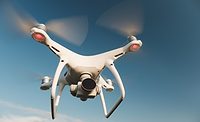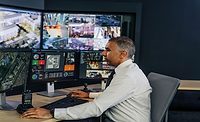Many sectors have adopted a robotic strategy to increase business and operational efficiency, including security departments and contractors.
When it comes to drone implementations in the security field, there are a number of areas where robots and drones have proven helpful, including in patrols, video surveillance and emergency management.
Let’s begin by reviewing the limitations of traditional foot patrols by dedicated human security in malls, warehouses, data centers and commercial facilities. None will be news to an experienced security veteran, but taken together, it’s a daunting list:
- Humans are expensive: Employees are a significant cost to many organizations. Depending on contracts, the employer cost of human security officers covers a wide range of expenses, from overtime to industry-specific training. With the high turnover in the field, many security managers struggle to retain qualified employees, and training represents a substantial cost in time and dollars for every new recruit.
- Humans are, well, only human: Humans overlook details, misremember what they saw, and, especially when the job is repetitive and monotonous, may not put the energy and focus into the tasks they’re hired to carry out. A typical logbook indicates that a patrol happened, but will never contain thousands of details regarding every window, stairwell, door or other indication of when an event may have occurred.
- Humans are limited by location and position: A guard can only be in one place at one time, and walking slowly through a facility means that only a tiny fraction of the area can be observed at a time. A clever criminal or troublemaker can easily wait in the shadows until the security officer has passed and continue their activities.
To combat these challenges, security teams leverage technology. The industry has long embraced cameras, but while they help security teams overcome some of the challenges associated with human security officers, cameras also introduce their own. Cameras still need to be monitored, and a bank of dozens, scores, or even hundreds of screens need a human observer — which re-introduces many of the weaknesses above. What's more, as many cameras are stationary, they need to be deployed liberally throughout a facility, and, even in the best-case scenario, leave blind spots that can be avoided.
This brings us to a robotic approach — specifically, an airborne fleet of autonomous drones. These platforms work 24/7, pausing only briefly to recharge automatically in docking stations. They fly throughout hallways, warehouse aisles or mall levels on pre-determined but flexible flight paths, searching out anomalies and recording video for later review.
Drones can help security teams save on cost, collect accurate data, and improve security visibility. A drone manages millions of calculations per second as it navigates, inspects and records its surroundings. As a fleet of drones can simultaneously patrol all areas of a facility, the coverage can be complete and consistent, with the ability to change course or investigate a suspicious indicator in more detail. What's more, a drone can spot an overheating generator or leaking pipe before a flood or fire does its damage. It can use advanced infrared sensors to peer into darkened areas and to detect movement not easily discernable. And flying closer to the ceiling than the floor, it can detect an intruder behind an obstacle or a dangerous loose bracket two stories up on a warehouse shelf.
There are industries in which robotics solve a particular problem — precision for microchip assembly, visual analysis for crop ripeness or disease, and of course, long-awaited autonomous cars. But it’s rare to have a sector like security in which a single paradigm shift can mitigate so many weaknesses, yielding a more effective result in productivity and shrinking the bottom line.
Will a drone-based security platform replace human security teams completely? No — we still need supervisors, judgment calls, and human interaction for customer and business stakeholders. But without a doubt, the error-prone, monotonous work of non-stop foot patrols is on its way to joining the antiquated routines happily left behind.



